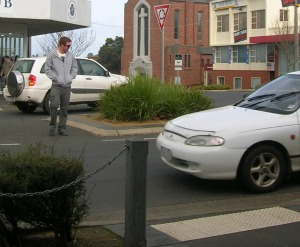Crossings save lives
7 Jul 2017
Transport for NSW have produced a report on Pedestrian trauma trends in the state, providing a useful picture of road safety issues for walkers.
After averaging about 50 pedestrian fatalities for seven years, NSW deaths rose to 61 in 2015 and then to 74 in 2016. This saw pedestrian deaths increase from about 14% of total fatalities to 19% in 2016. Let's hope that's a spike, not a trend. Across the nine years studied, serious pedestrian injuries were fairly consistent at about 1150 per annum - not getting worse, but not improving either.
There was a significant difference between men and women, with men making up about 70% of fatalities. The difference was most pronounced for children and younger adults. Across 2014-2016 girls made up only 1% of pedestrian fatalities, compared to 8% for boys, while men aged 17-49 were 28% of fatalities compared to 11% for women of the same age. This gender imbalance was not so pronounced for serious injuries.
Significant numbers of pedestrians who died had a blood alcohol concentration over 0.05, especially for those aged 17 to 49 (39%). However the proportion of pedestrian fatalities affected by alcohol seems to be declining.
Looking at pedestrian serious injuries, only 63% of hospital records could be matched with a Police crash report, indicating a level of under-reporting of pedestrian crashes in the traffic statistics.
As you would expect, most pedestrian collisions involve a car or 4 wheel drive, but trucks and buses were involved in a much higher proportion of fatalities (32%) than serious injuries that could be matched with a Police report (15%).
Compared to other road users, seriously injured pedestrians were more likely to have a lengthy stay in hospital. Pedestrians were three times more likely to stay in hospital for more than four weeks than car occupants or motorcyclists. The most common part of the body to be seriously injured was the head (29%).
There was a clear tendency for crashes on roads with higher speed limits to have more devastating consequences. Only 6% of minor injury crashes occurred on roads with a speed limit of 70 km/h or greater, but 25% of fatal crashes were on those roads.
Half of serious injuries and 32% of pedestrian fatalities occurred at intersections. The report says 851 serious injuries occurred where signals (traffic lights) were operating and for 404 of these "there was a pedestrian crossing." This suggests that for more than half of serious injuries at signalised interections there was no crossing. This gives an indication of the serious safety risks of traffic lights that do not have a crossing on all legs of the intersection.
It would be great to see the state government produce a similar report for Victoria, to help us better understand pedestrian crashes here.